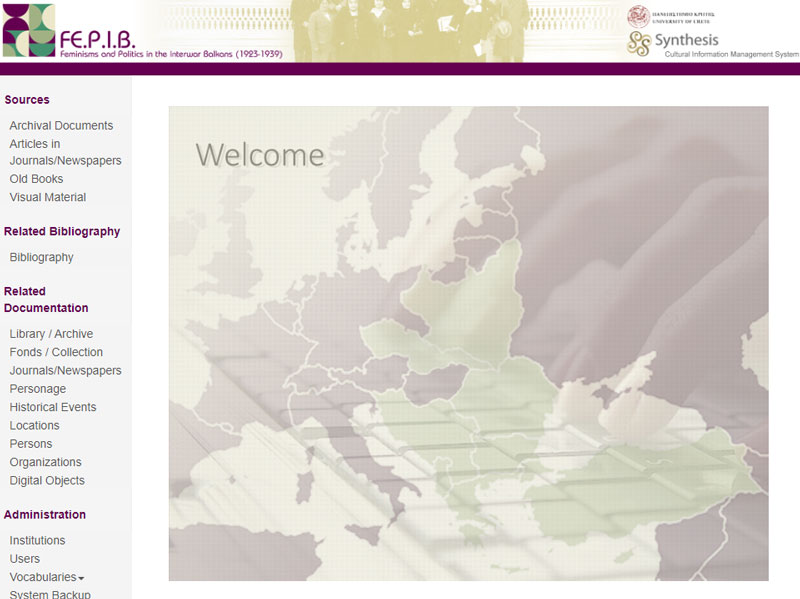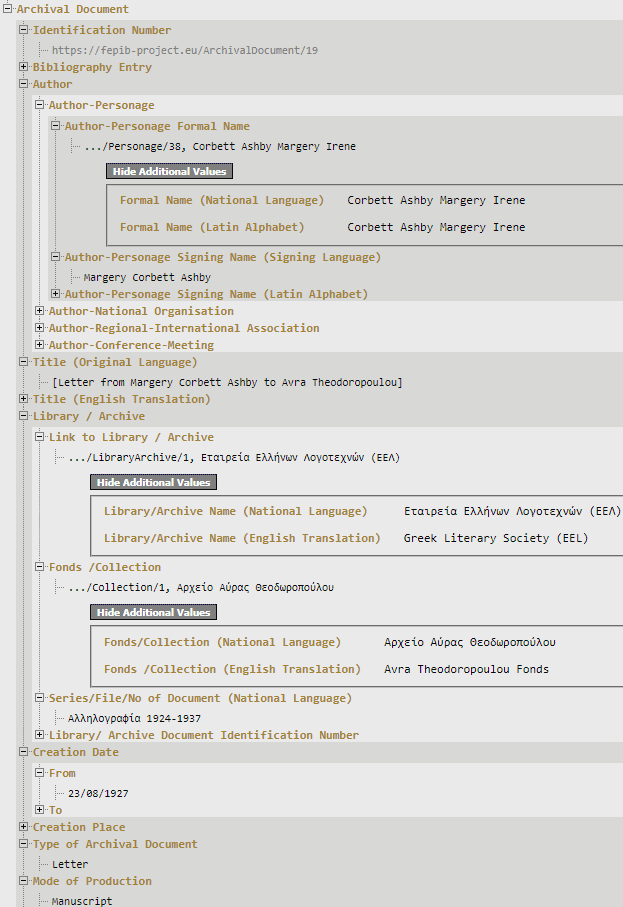by Pavlos Fafalios, Lida Charami (FORTH-ICS) and Katerina Dalakoura (University of Crete)
The project FE.P.I.B., hosted by the University of Crete and funded by the Hellenic Foundation for Research and Innovation (HFRI), explores the contacts, relationships and cooperation between the feminist/women's organisations of the Balkan and Central European countries, and particularly the entanglement of their emancipatory policies with the politics in the region during the interwar period. Researchers of FE.P.I.B. collaborate with the Centre for Cultural Informatics of FORTH-ICS for exploiting the information system Synthesis-Core as the project's data and knowledge management platform.
“Feminisms and Politics in the Interwar Balkans (1923-1939)” (FE.P.I.B.) is a research project in the field of transnational history of feminism, which aims to recover, fully document and analyse the collaborations among the interwar feminist/women’s associations in the Balkan and Central European countries, and to explore the entanglement of their activities and feminist policies with the politics and diplomacy established or pursued in the region during the interwar period [L1]. More precisely, the research focuses on the study of the most representative case of collaboration among Balkan women’s organisations, the Little Entente of Women (LEW) (1923-1939), involving feminist organisations from Greece, Bulgaria, Kingdom of Serbs, Croats and Slovenes /Yugoslavia (since 1929), Romania, and two Central European countries, Czechoslovakia and Poland [1]. The project also investigates the participation of feminist and women’s associations of the Balkan countries in the Balkan Conferences (1930-1934) and their activities in this context, as a continuation of the LEW’s activities and, most notably, as a direct involvement in government-planned policies in the Balkans and the wider region.
To cope with the project’s research objectives, the FE.P.I.B. research team collects and studies a large and diverse set of archival material of different types related to feminisms and politics in the interwar Balkans and Central Europe, including announcements, printed and not-printed articles, biographical documents, certificates, correspondences, resolutions, diaries/notebooks, legislations, letters, meeting minutes, press releases, reports, photos, images and many others. The source of this archival material is mainly libraries and archives in Balkan and Central European countries, including Greece, Serbia, Bulgaria, Romania, Slovakia, Czech Republic and Poland.
The collected archival material needs to be digitally organised, documented, and then studied for extracting important evidence related to the project’s objectives that can facilitate comprehension of entanglements, convergences and divergences, interpretations, possible causes, influences, and evolutionary trends. In particular, data management needs include: i) recording of metadata and content-based information about the different types of collected archival material, ii) documentation of rich information about the studied ‘entities of interest’, in particular about feminist associations (regional, national, international), political and socio-cultural associations, conferences, meetings, personages (feminist leaders/activists and other historical figures), iii) documentation of information about secondary entities related to the main entities, such as archives, libraries, collections, locations, historical events, and other, and iv) searching the data by exploiting the rich interconnections about the involved entities.
To cope with these data management needs, the FE.P.I.B. team collaborates with the Centre for Cultural Informatics [L2] of FORTH-ICS to create a configuration of the Synthesis-Core system [L3], especially adapted to be used as the project's main data management platform. Synthesis-Core is an information system for the scientific, administrative and collaborative documentation of cultural entities, which is configured based on specific use cases and needs. It is web-based, multilingual, and focuses on semantic interoperability. It enables data exchange between computer systems with unambiguous/shared meaning by making use of a standard model for data representation, namely the formal ontology CIDOC CRM (ISO 21127:2014) [L4]. The aim is the production of sustainable data of high value and long-term validity that can be reused beyond a particular research project. Technically, it utilises XML technology and a multi-layer architecture, offering flexibility in terms of versioning, workflow management and data model extension. The system has been widely used in different contexts, including cultural heritage / archaeology [2] and history of art [3].

Figure 1: The home page of Synthesis as currently configured for the FE.P.I.B. project.
In Synthesis-Core users create and document entities belonging to a set of pre-configured entity types. Each entity type has its own data structure (documentation schema), carefully designed to be fully compatible with CIDOC CRM (i.e. a direct mapping between a schema and CIDOC CRM can be defined). A documentation schema is XML-based and contains a set of fields organised in a hierarchical (tree-like) structure. The leaves in this tree-like structure are the documentation fields into which users enter data. Each documentation field is assigned to one of the following data types: link to other entity, link to a vocabulary term, link to a thesaurus term (exploiting the thesaurus management system THEMAS [L5]), unformatted free text, formatted free text, link to a web resource (URL), number, time expression (with support of historical time expressions, such as ‘ca. 1920’, ‘early 16th century’, etc.), location coordinates (by selecting a point or polygon on a map), location ID (TGN or Geonames), digital file(s).
In the context of FE.P.I.B, the following entity types have been currently configured that allow documenting information about the collected archival material and bibliography: i) archival document, ii) article in journals/newspapers, iii) old book, iv) visual material, v) bibliography, vi) library/archive, vii) fonds/collection, viii) journal/newspaper, ix) personage, x) location. Figure 1 shows the home page of Synthesis-Core, as configured for the case of FE.P.I.B, while Figure 2 shows a part of the documentation card of an entity belonging to the entity type archival document, which corresponds to a letter from Margery Corbett Ashby to Avra Theodoropoulou (of 23/08/1927).

Figure 2: A part of the documentation card of an entity belonging to the entity type “archival document” (corresponding to a letter from Margery Corbett Ashby to Avra Theodoropoulou, 23/08/1927).
Other system functionalities include map visualisation (for entities that have a relation to a location), versioning of the documented data, documentation in multiple languages, support of different user roles (system administrator, agency/group administrator, editor, guest), data export (in XML or RDF, as well as in PDF or DOCX based on predefined templates), and advanced entity search (within or across entity types).
The system configuration is still under development. Currently, we are in the process of designing the documentation schemas of the remaining entities of interest, in particular national organisations, regional-international associations, and conferences/meetings. In parallel, the research team (consisting of ten researchers) has started documenting information about the collected archival material, bibliography, and personage. The current number of documented entities per entity type is the following: 98 archival documents, 645 articles, 36 old books, 16 visual material items, 182 bibliographical item, 18 libraries/archives, 16 fonds/collections, 45 journals/newspapers, 106 personages, 14 locations.
Acknowledgements: This work has received funding by the Hellenic Foundation for Research and Innovation (H.F.R.I.) under the "2nd Call for H.F.R.I. Research Projects to support Faculty Members & Researchers” (Project Number: 03050).
Collaborators: Konstantina Konsolaki (FORTH-ICS), Chrysoula Bekiari (FORTH-ICS), Dimitra Samiou, Vanessa Geragori (Univ. of Crete), Charitomeni Giasafaki (Univ. of Crete), Eleftheria Papastefanaki (Univ. of Crete), Eleni Fournaraki (Univ. of Crete), Maria Bucur (Indiana Univ.), Daskalova Krassimira (Univ. of Sofia), Gabriela Dudeková Kováčová (Slovak Academy of Sciences), Ιvana Pantelić (Institute of Contemporary History, Belgrade).
Links:
[L1] http://feminisms-politics.ia.uoc.gr/
[L2] https://www.ics.forth.gr/isl/centre-cultural-informatics
[L3] https://www.ics.forth.gr/isl/synthesis-core
[L4] https://cidoc-crm.org/
[L5] https://www.ics.forth.gr/isl/themas-thesaurus-management-system
References:
[1] K. Dalakoura, “Feminisms and politics in the interwar period. The Little Entente of Women (1923-1939),” Aspasia, vol. 16, Berghahn Journals, 2022.
[2] C. Bekiari et al., “Building comprehensive management systems for cultural-historical information,” CAA, Archaeopress, Oxford, 2014.
[3] P. Fafalios et al., “Towards semantic interoperability in historical research: documenting research data and knowledge with synthesis,” ISWC, Springer, 2021.
Please contact:
Pavlos Fafalios, Centre for Cultural Informatics, FORTH-ICS, Heraklion, Greece
Katerina Dalakoura, Department of History and Archaeology, University of Crete, Rethymno, Greece











